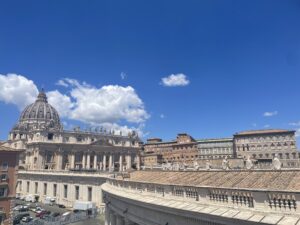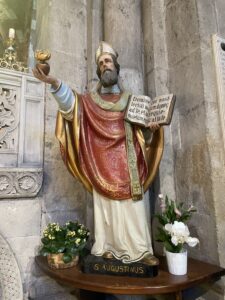Pope Leo XIV selected as his motto the Latin phrase “In Illo uno unum,” which means “In Him who is One, we are one.” It comes from St. Augustine’s commentary on Psalm 127, 3 and highlights the simple reality of unity in Jesus Christ. Knowing that unity is a work-in-progress, his words give us real insight into who he really is: a person who has always been a bridge-builder. His words were not just a recommendation for others but an insight into who he has always been. Building bridges is certainly necessary, but it is also quite challenging. He will need our prayers and each of our own efforts to diminish divisions – a cross that we carry together.
He also used the first moments of his introduction to the world to say: “I am a son of Saint Augustine, an Augustinian.” What can we expect from a Pope whose life has been spent in service to the people of Peru, to his brother Augustinians and, most recently, to the whole church?
The Order of Saint Augustine was established in the middle of the 13th century to bring the message and life of the Church into the cities of that time. The spirit of the Order of St. Augustine harkens back to the life and teachings of St. Augustine – a thoughtful and humble bishop who valued friendship most highly and recognized the deeply human need for others to live and deepen one’s own faith. St. Augustine had to learn how to nourish his own need for God before he was called to give anything to others. He could then say that he would do his best to give his people the same food that had nourished him. That is the kind of wisdom that everyone needs – wisdom that I hear again in the words of Pope Leo XIV.

I have known Pope Leo personally for about 20 years, dating to a time when we were members of the Augustinian communities located next to St. Peter’s square in Rome. Even though he held the highest position of leadership in the Order at that time, he was very much a member of the community. A naturally quiet and thoughtful person, Pope Leo enters comfortably into conversation. His words, taken from Augustine, from the balcony above St. Peter’s Square were typical: “With you I am a Christian, for you a bishop,” adding “So may we all walk together toward that homeland that God has prepared for us.” Pope Leo clearly accepts his role as bishop, but his sense of belonging to God’s people and wanting to move forward together with all of us is deeply personal and genuine.
One dimension of Augustinian life is the need to deal with the many things that make us different because of the life experiences we bring when we join the Order. In the Rule that Augustine wrote for us to follow, he asks us to “live harmoniously in your house, intent upon God in oneness of mind and heart” no matter how different we are. That invitation to “honor God in yourselves, whose temples you have become” is very much a part of the life experience of Pope Leo. Whether he was living in Chicago, Chulucanas, Peru or Rome, when he was a parish priest, a superior in the Order or a bishop, he was the same person – a one carry-on traveler and a compassionate listener.
There is an interesting historical connection that one of my Augustinian brothers noticed. Bob Prevost became Pope Leo on May 8, 2025. On that same date in 1844, Olde St. Augustine Church at 4th and Vine in Philadelphia – our first foundation in the United States – was burned down by the Nativists, a political party (the Know-Nothing Party) that was opposed to the immigration of Irish Catholics. The school that was attached to the church, Augustinian Academy, was not destroyed, but the Augustinians saw the need to make a change. They moved the school and its library to a recently purchased property outside the city – a property that became what is now called Villanova University.
Another historical connection – pointed out by a colleague at Villanova – can be seen in the decision to take the name, Pope Leo. In fact, Pope Leo XIII was a great friend of the Augustinian Order, both in his devotion to Our Mother of Good Counsel and in the decisions to restore the church in Pavia and to have the remains of St. Augustine transferred there. Pope Leo XIV, in fact, went to the Augustinian Church in Genazzano to pray at the shrine of Our Mother of Good Counsel just two days after being chosen as Pope. Pope Leo XIII also approved the acquisition of the land immediately adjacent to Saint Peter’s Square for the Augustinian General Curia and the international house of studies.
As I conclude these reflections, let me say something about how his selection as Pope touches me – a brother, friend and admirer. There is, first of all, a sense of awe as I recognize that he is not stepping into a role of fame and glory so much as he is accepting a cross. In this divided world – a time not unlike the deep divisions that marked the time of St. Augustine himself – the work and ministry of Pope Leo XIV is uniquely important. He will need every bit of prayerful support that I or anyone can give. It also becomes all the more significant that my own work and ministry feels more significant because of the fraternal bond which unites us. I am sure that I don’t really know what it really means for me to say that, but it does at least mean that we are still brothers in Augustine and our very lives still matter to one another – at least in a way similar to the ways that each of us honors our human families by the choices we make and the way we live. So he is now Pope Leo XIV, but he also remains ‘Bob’ as well – united in mind and heart as St. Augustine asked us to be.
Allan Fitzgerald, OSA
Fr. Allan Fitzgerald, OSA, entered the Order of Saint Augustine after his first year at Villanova University (1960). He has taught in the Department of Theology and Religious Studies from 1972-1997 and again from 2009 until 2019. He now teaches in the College of Professional Studies for a new program for special education students.
Fr. Allan became the editor of Augustinian Studies in 1990, the only English language journal devoted entirely to Augustine’s thought and influence. He edited an encyclopedia of Saint Augustine (Augustine Through the Ages: An Encyclopedia), published in 1999. He also taught at the Augustinian Patristic Institute in Rome (1997-2009) and returned to Villanova as the director of the Augustinian Institute, a position that became a full-time position in 2011. He resigned from that position in 2019 but continues as Director of Special Events for the Augustinian Institute.